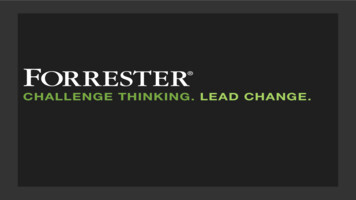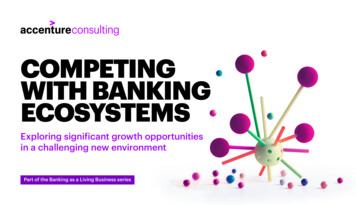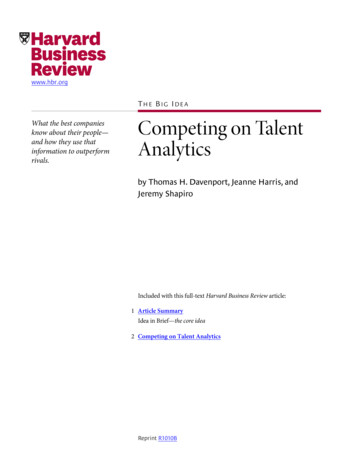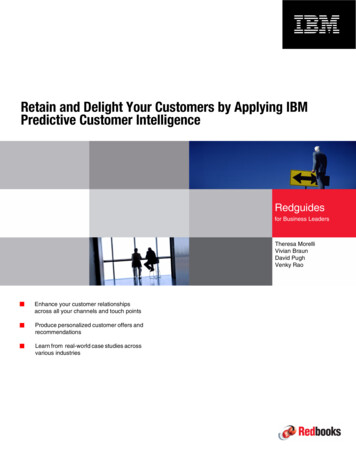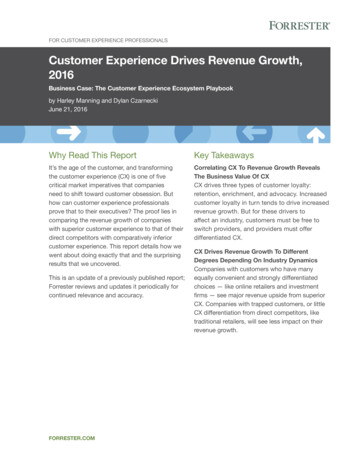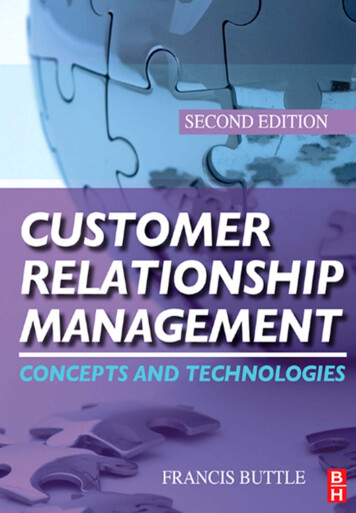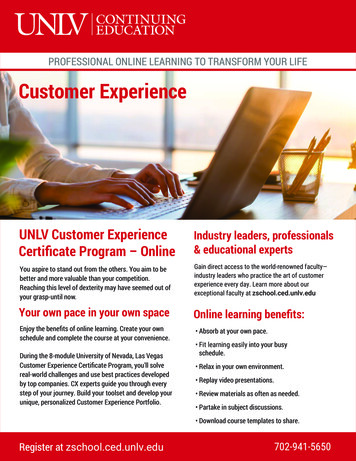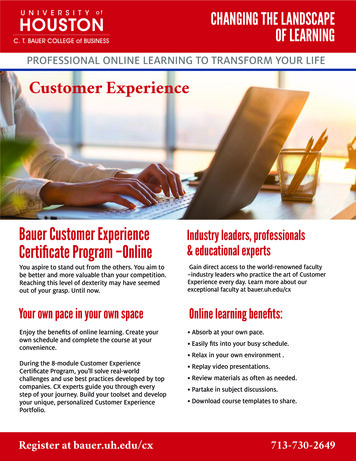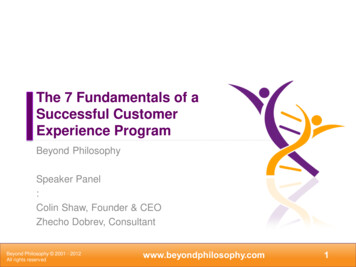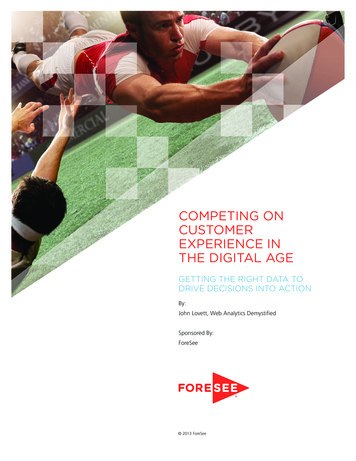
Transcription
COMPETING ONCUSTOMEREXPERIENCE INTHE DIGITAL AGEGETTING THE RIGHT DATA TODRIVE DECISIONS INTO ACTIONBy:John Lovett, Web Analytics DemystifiedSponsored By:ForeSee 2013 ForeSee
COMPETING ON CUSTOMER EXPERIENCE IN THE DIGITAL AGEEXECUTIVE SUMMARYWe have entered into a new age where competing for customers using traditional methods like price,distribution, or product features simply isn’t enough. The digital age has put the consumer in control withstronger voices, better information and lower switching costs. This newfound consumer empowermentalso comes with lofty expectations that, if left unfulfilled, will send customers scampering to your closestcompetitor. Which begs the question: Is there anything left to compete on?The answer is a definitive yes. Customer experiences are the new battleground for companies seekingcompetitive advantage. It is still very early in the fight as eConsultancy reports, “only 26% of companies havea well-developed strategy in place for improving customer experience.” Companies that are first to deliverbetter customer experiences will have an edge when competing to get consumers to open theirwallets and preserve their loyalty.Savvy organizations are entering the ranks of customer experience competitors by using data. Customerexperience data holds the secrets of customer behaviors and companies measuring the voice of customer ina systematic way are gaining the competitive edge. By collecting the right data and using a framework foraccelerating insights to action, digital leaders are optimizing their business performance.This paper, sponsored by ForeSee, will describe how to quantify the digital customer experience and howto progress from observation – to decisions – to actions. If your organization seeks to compete on customerexperience, then this is a must read.2
COMPETING ON CUSTOMER EXPERIENCE IN THE DIGITAL AGEQUANTIFYING THE DIGITAL CUSTOMER EXPERIENCECustomer experience by its very nature is subjective. Whereas one individual might be exceptionallysatisfied with an online experience, another might perceive the exact same experience as underwhelming.Worse yet, someone affected by negative circumstances beyond your control might view an identicalexperience as thoroughly disappointing. The experience of any given individual may be influenced by amultitude of factors including: preconceived notions, personal preferences, or even something asuncontrollable as the weather. Yet, quantifying the digital experience can be accomplished with consistencyand precision. The first challenge is identifying how to effectively collect data.5 KEY QUESTIONS FOR QUANTIFYING EXPERIENCECustomer Experience technologies available on the marketplace today cover a broad range of datacapabilities that provide everything from anecdotal evidence to empirical facts. For most digital leaders,finding the appropriate mix requires a combination of technologies and solutions that lead to increasinglysharper and more realistic perspectives on the digital customer experience. But even before managementcan put their teams and tools to work, they must first clarify the core components of the digital experience.By answering the following questions organizations can sum the customer experience across theirdigital properties: Was the site or application easy to navigate? Was the content relevant and helpful in answering your questions? Did the website or application perform according to your expectations? Was the functionality sufficient to accomplish your task? Did you accomplish the task you set out to do?3
COMPETING ON CUSTOMER EXPERIENCE IN THE DIGITAL AGE4While each of these questions is important in the overall customer experience, the last question is arguablythe most critical. Did you accomplish the task you set out to do? If customers answer no, then yourdigital offering has failed. Conversely, if you provide the utility to accomplish tasks online and deliver: fluidnavigation, helpful content, adequate performance, and sufficient functionality, then you will be well onthe path towards satisfying customers. Yet within each of these questions lies data about how improve andcompete on customer experience.DATA COLLECTION METHODS AND APPLICATIONSFortunately for us, data is prevalent in today’s digital environments.VALUEDATA AVAILABLE FOR QUANTIFYING INDIVIDUALCUSTOMER apsVOLUMEFigure 1: Customer Experience Data Volume and Value
COMPETING ON CUSTOMER EXPERIENCE IN THE DIGITAL AGEFigure 1 on page 4 depicts several types of data collection methods that can (and should) be used toevaluate digital customer experiences. Notice that each type of solution offers varying degrees of volumein terms of the amount of data typically collected, and value as a measure of the ability to truly understandthe user experience.For this reason, Web Analytics Demystified advocates employing a variety of data collection tactics.Using technologies that collect a large volume of data can amass an extensive list of issues andopportunities. While value oriented technologies are helpful in prioritizing efforts on the areas drivingpositive business outcomes.APPLYING DATA FOR ENTERPRISE DECISIONSIt’s a well-known fact that you cannot manage what you don’t measure. As such, quantifying the digitalcustomer experience begins with behavioral data.Nearly every organization uses web analytics data as a starting point for identifying and quantifying theactions taken by their customers. Many companies are also leveraging focus groups and testing to validatehypotheses as well as showing their customer’s they are listening by monitoring social media. But simplytracking, watching, and listening to customer comments is not enough.Leading organizations capture the voice of customer by consistently measuring the customer experience usingstandard elements that harken back to the five key questions mentioned earlier. These core elements serve aspredictors for future behaviors, allowing companies to prioritize the critical areas impacting their experiences.Using verification through session replay is the final frontier in quantifying digital customer experiences.The ability to verify user complaints or exaltations within a DVR-like session replay technology isunquestionably quantifiable. Organizations competing on customer experience rely on session replaytechnology as the pinnacle for verifying digital experiences with absolute resolve.5
COMPETING ON CUSTOMER EXPERIENCE IN THE DIGITAL AGE6ACCELERATING FROM INSIGHT TO ACTIONThe volume of data available from both behavioral and feedback technologies is staggering. A typical largeenterprise might see 22 million online visitors in a given month and have digital data from each click, event,and transaction across every session. Add to that an enterprise that’s collecting page level customer feedback,which adds a huge element of unstructured content in the form of open-ended comments that must beanalyzed, coded and addressed. For many organizations, sorting through all this data is simply overwhelming.To identify opportunities within these petabytes of data is akin to going on a fishing expedition in hopes oflanding a great white whale. What’s worse, for organizations that use session replay data for troubleshootingand issue resolution, filtering through tens of thousands of sessions is like searching for a needle in a haystack. Yet companies that compete on customer experience take a markedly different approach.THE QUANTIFIED USER EXPERIENCE FRAMEWORKRather than getting paralyzed by all of the data available, leading organizations quickly focus on theright data by using a scientific model that identifies the key components driving customer experience.Using a customer experience model can help digital leaders identify what areas are impactingthe customer experience, which leads to the ability toassess the situation, and helps them decide what toIDENTIFYdo about it. This enables prioritization and ultimately,ASSESSa resolution. Using these basic principles as aframework for consistently understanding howyou’re serving your customers and as an opportunityPRIORITIZEto elevate the experience, organizations canimplement a process that generates swift andimpactful improvements.RESOLVEFigure 2: A Framework for Improving the Digital User Experience
COMPETING ON CUSTOMER EXPERIENCE IN THE DIGITAL AGE7While building a digital customer experience model may sound complex, vendors like ForeSee deliver aconsistent method for understanding the customer experience by systematically surveying customers tounderstand key elements of digital experiences. Elements such as Product Browsing, Price, Look and Feel, SitePerformance, and Navigation can be plotted to help clients determine where to focus efforts. Figure 3 belowshows an example of a ForeSee priority map. This mapping enables digital leaders to maintain priority focuson the elements of the customer experience that have the greatest business impact.STATUS QUO REQUIREDHighMAINTAIN OR IMPROVEKEY:Position ofeach bubbleindicates itsscore and impact.Site ctionalityLook and FeelNavigationLowLowMONITORIMPACTFigure 3: Sample ForeSee Customer Experience Priority MapTOP PRIORITYHighSize ofeach bubblealso indicatesthe relavtivesize of impact.
COMPETING ON CUSTOMER EXPERIENCE IN THE DIGITAL AGEWhile the approach depicted above is a best practice for quantifying customer experience, organizations thatuse this methodology to assess discrete functions on their digital properties can get even more granular aboutevaluating user experiences. Specifically, competitive organizations that are focused on outcome-basedactivities such as the customer acquisition experience, the purchase experience, or the shopping cartexperience can put critical functions in context. Further analysis allows organizations to assess customerexperiences based on segments of visitors. For example, if identification reveals that navigation is an issueaffecting user experiences, an organization can filter customers by first-time visitors and determine how theyrate the site. When this data is coupled with session replay technology, they can watch visualizations of newusers struggling with a sub-par experience. This approach has countless applications when applied to desiredoutcomes or specific business goals.DTE ENERGY USES GOALS TO SPARK ACTIONOne organization that competes on customer experience is DTE Energy. Headquartered in Detroit, Michigan,DTE Energy provides electric and/or gas services to over three million customers throughout Michigan.For them, providing the best possible user experience is paramount to keeping customers happy andmeeting their corporate goals. DTE Energy uses a combination of products and services from ForeSee toidentify, assess, prioritize and resolve user experience issues.DTE Energy turned to the combination of ForeSee’s Satisfaction Analytics and SessionReplay when it wastrying to improve their site visitors online task accomplishment in order to reduce costly call center traffic.8
COMPETING ON CUSTOMER EXPERIENCE IN THE DIGITAL AGEDTE Energy’s challenge was first identifying a problem that didn’t appear to exist and then getting to theroot cause. When call center comments indicated that users were having issues updating their accountinformation online, the systems appeared to be working properly. By using Satisfaction Analytics to focuson the specific segment of users that attempted to update their accounts online, DTE Energy was able toidentify that they did have an issue with one of their online processes. In fact, using insights from ForeSeedata they learned that 65% of users indicated that they would call the call center if they experienced troubleupdating their account information. This assessment of the data allowed DTE Energy to prioritize the issuebecause it was precisely the behavior that DTE Energy was trying to prevent. Using ForeSee SessionReplayto watch actual visitor sessions, they pinpointed the glitch in their process which required users to delete anexisting credit card and re-enter their information to make a simple change. Although this process workedaccording to design, it wasn’t intuitive for users and resulted in many of them calling the call center to ask forassistance. By analyzing their data and viewing session replays of actual users struggling with updating theiraccounts, they were able to quickly verify the issue and take action to resolve it. By following the framework,DTE Energy was able to satisfy one of their corporate goals of reducing high cost call center traffic by takingaction to improve the digital customer experience.ACTIONS SPEAK LOUDER THAN WORDSWhile there are many technologies that can illuminate customer experience issues or opportunities,stakeholders often need to see it to believe it. Session replay delivers the evidence that converts non-believersinto evangelists, it’s the visual evidence that you bring to developers who simply cannot believe that theirdesigns don’t work, and it’s the fodder for bulletproof business cases that sway executives into action.9
COMPETING ON CUSTOMER EXPERIENCE IN THE DIGITAL AGEThe benefit of using a visual solution that is tied directly to a voice of customer measurement system isthat it provides a cohesive view of the customer experience as seen through the customer’s eyes. Companiescompeting on customer experience use voice of customer measurement to shed more light on theopportunity and deliver the data necessary to frame the impact on customer experience. Adding in sessionreplay, stakeholders can see precisely where the opportunity exists and identify the root cause of thecustomer struggle. By using segments to group common customer experiences, organizations can build thebusiness case for improvement and use session replays as the final step to convince stakeholders and seniorexecutives. Using this type of diagnostic process as part of an organizational workflow enables companies tobuild strong cases for improvement with data as definitive evidence and visual proof to expedite action.FINDING SYNERGY BETWEEN DATA & DECISIONSWhile it’s easy to recite buzzwords like data-driven marketing, Big Data, and data science, putting your datainto action requires more than just catchy slogans. Organizations that are competing on customer experienceare using data to identify opportunities and build business cases that lead to sound business decisions.Decisive action comes from combining the business case with supportive visual evidence.SOMETIMES YOU ONLY GET ONE CHANCE, MAKE IT COUNTWhen competing on customer experience, leading organizations know that a first impression is a lasting one.That’s why they rely on data. Identifying key elements that impact user navigation or ability to transact onlineprovides a focused entry point for ensuring positive first impressions. Using a combination of clickstreamdata, voice of customer measurement and session replay—whether the data is sourced from multiplevendors or from a single solution capable of providing all of these data streams, like ForeSee—organizationscan review data to find the most critical areas of their sites and applications. This method of leading withthe data enables companies to use page navigation data to see where people are spending time on theirdigital assets, prioritize issues by measuring the voice of customer and assessing the importance ofnavigation, review open-ended comments to learn trends and issues, and then view session replays tocrystalize findings and validate assumptions.10
COMPETING ON CUSTOMER EXPERIENCE IN THE DIGITAL AGEFigure 4: Sample ForeSee SessionReplay Heat Map showing Mouse MovementFigure 4 above depicts a customer session with a heat map showing where the customer moved their mouseand which clicks they made during their session. Businesses using this type of visual can verify their findingsand ensure positive experiences.TARGETING ACTIONSEach interaction a consumer has with your business is an opportunity to collect data about the experienceand to learn from it. The fact that data is amassing so quickly means that there is much to analyze, but ascustomers enter buying cycles, your organization doesn’t have time to go on fishing expeditions to wadethrough open-ended satisfaction data or view individual user sessions looking for issues. You need answersand you need them fast. By systematically reviewing data with key outcomes, segments, and experiences inmind, companies can see problems as they manifest and resolve them before they hurt your business.11
COMPETING ON CUSTOMER EXPERIENCE IN THE DIGITAL AGE12Further, by using a data-driven process like the one identified in Figure 5 below organizations cantarget actions.CUSTOMER EXPERIENCE TECHNOLOGY & SocialMediaFocusGroupsHeat MapsFigure 5: Competitive Organizations Use Customer Experience Technology and ProcessUltimately, companies that utilize technology in the inner rings will move from insight to action more quickly.By effectively managing your data and applying a process to expediting actions, organizations will deliveroutstanding customer experiences.
COMPETING ON CUSTOMER EXPERIENCE IN THE DIGITAL AGECONCLUSIONCustomer experience has never been more critical for businesses. With consumers holding the megaphoneand broadcasting their good experiences and bad, businesses cannot afford to move slowly. By employingthe combination of quantitative voice of customer measurement data and observational sessions that trulyrepresent your key customers, you can keep pace with those customers by using an internal process that allows you to identify, prioritize, and resolve issues rapidly.By following the processes and framework outlined in this white paper, companies can enter the ranks ofthose businesses that are truly competing on customer experience. To learn more about competing oncustomer experiences in the digital age, or to investigate technology solutions that make this happen, reachout to Web Analytics Demystified or ForeSee for details.ABOUT THE AUTHORJohn Lovett is a veteran industry analyst and expert consultant who has spent the past decade helpingorganizations understand and measure their digital marketing activities. As a Senior Partner at Web AnalyticsDemystified, Lovett regularly consults with leading enterprises to offer strategic guidance for buildinginnovative digital measurement programs. Prior to joining Web Analytics Demystified, Lovett was aSenior Analyst with Forrester Research, where he was responsible for analytics and optimization technologies.Currently, Lovett is the President of the Digital Analytics Association. He is also the co-founder of theAnalysis Exchange program that introduces eager students to analytics by helping non-profits with mentoredanalysis. Lovett is the author of Social Media Metrics Secrets. He lives near the ocean with his wife,three boys and yellow lab.13
COMPETING ON CUSTOMER EXPERIENCE IN THE DIGITAL AGEABOUT WEB ANALYTICS DEMYSTIFIEDWeb Analytics Demystified has more than 25 years of experience helping companies choose digitalanalytics solutions and build strategic models for deployment within the enterprise. Its staff of formerForrester and Jupiter Research analysts has literally written the book on digital reporting and analysis.The organization provides strategic guidance on analytics to some of the world’s best-known brands.Contact Web Analytics Demystified by calling John Lovett at (603) 262-5636,or visit www.webanalyticsdemystified.com.ABOUT FORESEEAs a pioneer in customer experience analytics, ForeSee continuously measures satisfaction across customertouch points and delivers critical insights on where to prioritize improvements for maximum impact. BecauseForeSee’s superior technology and proven methodology connect the customer experience to the bottomline, executives and managers are able to drive future success by confidently optimizing the efforts that willachieve business and brand objectives. The result is better business for companies and a better experience forconsumers. Visit us at www.foresee.com for customer experience solutions and original research.14
For this reason, Web Analytics Demystified advocates employing a variety of data collection tactics. Using technologies that collect a large volume of data can amass an extensive list of issues and opportunities. While value oriented technologies are helpful in prioritizing efforts on the areas driving positive business outcomes.
